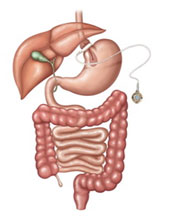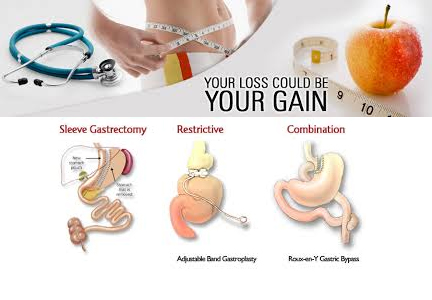GASTRIC BAND SURGERY IN INDIA AT LOW COST FOR OBESITY
What is an adjustable gastric band?

The gastric band system is composed of an adjustable gastric band that is placed around the stomach during a surgical procedure. This procedure is generally performed by laparoscopy, and the placement of this band reduces the size of the stomach. This band is connected to a fixed capsule located just under the skin, which permits its size adjustment: this means that the stomach accepts less food. If less food is ingested, the body will draw from its own reserves of fat to obtain the energy it needs to function properly. This technique is associated with a low rate of postoperative complications. One of the main advantages of the band is that its diameter can be adjusted to suit and meet your personal needs.
How does the adjustable gastric band work?
The gastric band system is composed of a silicone band that is placed around the superior part of the stomach. This band placement considerably reduces the size of the stomach. As the opening of the stomach and digestive tract size are reduced, food within the stomach will take longer to reach the intestines. This translates into feeling fuller much more rapidly, as well as feeling full for a longer period of time. The internal surface of the band is inflatable and contains a liquid (saline solution). This inflatable part is filled by a reservoir that is placed under the skin and connected to the band by a tube. The surgeon can control the quantity of liquid in the reservoir by inserting a fine needle into the skin. If the band is too tight, the surgeon will remove some of the liquid. If the band is too loose, it can be tightened by adding more solution into the reservoir. The adjustment of the band can be performed during a simple consultation: it does not require any further surgical procedure.
How is the gastric band put into place?
Usually, the gastric band is inserted and placed around the stomach by laparoscopy. This is done in the following manner: the surgeon makes a few small incisions on the abdominal cavity. Through these incisions, he/she introduces deep tubes that serve as access routes for the long and fine surgical instruments. With a small camera that is introduced into one of these tubes, the surgeon can see inside the body. This is considered a non-aggressive surgical technique. You will feel less pain following this type of procedure in comparison to an “open” procedure, in which a larger incision is made on the abdomen. This type of procedure also enables the patients to recover more promptly and to return to their usual daily activities within a few days only. Most certainly, the patient and/or the surgeon can decide, for various reasons, to insert a gastric band system either by a larger incision on the abdomen, or by laparoscopy. You will need to discuss with your surgeon about the different surgical options that will be proposed to you.
Who can benefit from the gastric band system?
In order to determine whether the gastric band system is a suitable method for you, we will proceed to a careful evaluation based primarily on the following criteria: you are between 18 and 60 years of age; your current weight is equivalent to twice your ideal weight or more, or your current weight is at least 45kg greater than your ideal weight; you suffer from health problems related to severe obesity such as diabetes, cardiac and/or bone and joint-related problems, snoring with regular temporary respiratory arrests (sleep apnea); the excess weight you carry has persisted for more than 5 years, you have made serious attempts to lose weight without any long-lasting results, you do not suffer from any apparent disease causing your excess weight situation; you are prepared to radically modify your eating habits and lifestyle; you are prepared to accept that your treating specialist will follow you on a regular basis; and, you do not use hallucinogenic drugs. Worthy of mention, some surgeons have reported that patients who crave sugary foods, more specifically the ones who consume considerable quantities of such sugary products or drink large amounts of high-calorie beverages, will not obtain satisfactory results from the gastric band system. In general, the gastric band method is not used for patients whom have a body mass index (BMI) of less than 40. However, if your BMI is between 35 and 40, your surgeon may have legitimate reasons to recommend this procedure, such as the presence of significant health issues secondary to your obesity status. Your surgeon will provide you with further information with regards to the selection criteria, and will determine if this procedure is right for you.
Risks and Complications
Complications can occur during or following any surgical procedure, including a gastric band system procedure. Broad-spectrum surgical complications consist of pulmonary problems (including infections), liver or spleen lesion, thrombosis, and rupture of the operative wound. Specific complications pertaining to the gastric band system procedure include sliding of the stomach through the band, and dilation (the stomach is distended because too much food was ingested, which can cause it to incline, resulting in the blockage of the opening). Furthermore, perforation of the stomach during the procedure can also occur. Should one of these complications arise, you may require a longer hospital stay or need to be re-hospitalized again. Other minor complications can also occur, but these generally have little impact on the healing process.
Removal of the band
In some cases, it may be necessary to remove the band. If the band was inserted by laparoscopy, it can usually be removed via the same surgical route. As it is composed of specialized materials, it is unlikely that the band will proliferate within the stomach and surrounding tissues. At the present time, unless a complication arises or in the event that you do not lose any weight, we do not possess any clinical reason to believe that the band should be replaced or removed at any given time. Despite this, it is currently difficult to predict whether the band can be left in place for an entire lifetime or not.
The Surgicial Procedure
In general, you will be hospitalized the morning of the procedure. The procedure itself usually lasts approximately 2 hours, and is performed under general anesthesia. As previously mentioned, the procedure is typically performed by laparoscopy. The gastric band system is fixed to the superior part of the stomach. This creates a small stomach above the band. The remaining stomach component remains in its normal position, under the band. In order to place the reservoir in the abdominal cavity, the surgeon makes a small incision, usually by enlarging one of the incisions made prior for the insertion of the laparoscopic tubes.
After the procedure
Once the analgesic effects of the anesthesia will have subsided, you may experience pain or discomfort for a certain period of time. This pain can however be easily controlled with common pain relievers. The nurses will encourage you to get up and mobilize yourself as soon as possible following the procedure. This is very important in order to help prevent the development of a thrombosis (blood clot in leg), or various pulmonary problems. The expected duration of your hospital stay is approximately 36 hours.
During the first days following the procedure, you may feel a little more tired than usual at the end of the day. This is generally due to the anesthesia. If no complication arises, you will be able to return to your regular activities one or two weeks following your surgery.
Eating and drinking following the procedure
Without any exception, your surgeon and/or dietician will discuss your new dietary regimen in detail with you. You will need to meet with these specialists in order to receive specific instructions to follow with regards to your diet. They will progressively inform and help you adapt to your new lifestyle, as well as your new eating habits.
Following the procedure, it is extremely important that you follow these instructions. More specifically, during the first weeks that follow the procedure, it is important that you do not unnecessarily dilate the “small” stomach located above the band. Care and time must be provided to this new gastric structure in order to permit its optimal adaptability. This adaptation process may take a course of a month or more.
Generalities
Liquids will quickly pass through the reduced-size stomach, and therefore will not cause you to a feel full very rapidly. You will however need to be more attentive with regards to food, as excessive food intake, or ingestion of large pieces of food may block the narrow gastric opening. This blockage is an irritating complication that can easily be prevented by adequately chewing food and eating small portions at a time. Attempt to eat 3 small meals a day. Make sure these meals contain the nutritional elements required. A healthy meal consists of vegetables, meat, bread, and/or milk products. Your surgeon and/or dietician will be able to help you with regards to meal planning.
The first days following the Procedure
Immediately following the surgery, you may take a sip of water once in a while, or suck on an ice cube. It is not recommended nor is it necessary to drink larger quantities, as you will be receiving an intravenous perfusion of fluid to maintain the appropriate level of liquid intake your body requires. The day after your surgery, you will increase your liquid intake, but will proceed with only small amounts at a time. Do not drink water only: choose a beverage containing an adequate amount of calories. In order to prevent nausea and vomiting, refrain from drinking too much.
The first four weeks
Beverages and very soft foods are recommended for the first four weeks following the procedure.
- Broths or light soups: no thick broths or soups containing vegetables or meat.
- Yogurt: yogurts that are particularly liquid in consistency and that are low in fat.
- Milk: skim milk preferably.
- Desserts: low-fat ice cream, but in small portions only.
- Fruits: juices or soft fruits such as peaches, bananas, and pears.
During the first four weeks following the procedure, you will eat foods (as per the dietician’s recommendations) that you will not be allowed to eat once you will have fully recovered. The reason for this is that these specific foods have a very high calorie count, and are not appropriate for a new diet (weight-loss regime). Furthermore, during the first four to six weeks following your surgery, your weight loss process will not begin, but you will permit your new stomach to adapt to this eventual weight loss process.
What will you eat after these four weeks?
Following this four-week period, you will progressively begin to eat soups of slightly thicker consistency. Afterwards, you will be able to gradually proceed to eating more solid foods. During this phase, some foods might always cause you problems, such as bread, red meat, or rice for example. It is recommended that you eat mainly white meat (poultry, veal) and fish, as these meats have a softer consistency and are more easily digested. Do not forget to chew all your foods thoroughly. During this period, if you experience difficulties with solid foods and/or are afflicted with nausea and vomiting, it is recommended that you return to the clear liquid diet described above. You will try again to progressively incorporate solid foods after a successful period of soft food ingestion. Do not hesitate to ask your doctor or dietician for advice: they will provide you with specific recommendations according to your personal situation. When you will no longer experience difficulties with solid foods, it will be time to pay close attention to your regime. At this point, you will need to avoid high-calorie beverages. Limit your liquid intake to broths, tea, coffee (preferably without any added sugar), as well as mineral water. You will find a general diet guide below. This guide will help you prepare delicious and reasonable meals containing the adequate nutritional elements, while also being low in sugar and fat.
10 Important Rules
The ten important rules outlined below with regards to foods, beverages, and exercise will help you to achieve the most optimal weight-loss results. Do not forget: your willingness to embrace a new way of eating is of crucial importance for this procedure to be a successful weight-loss process.
- Eat only three small meals daily
- Eat slowly and chew thoroughly (masticate approximately 15 to 20 times per bite)
- Stop eating as soon as you feel full
- Do not drink while you eat
- Do not eat in between meals
- Eat only fresh produce
- Avoid high-fiber foods
- Drink enough during the course of the day
- Drink only beverages that are low in calories
- Do at least 30 minutes of exercise daily
Frequently Asked Questions
Will I be very sick following the procedure?
The gastric band system has been designed to limit food consumption in a safe and pleasurable fashion for the patient. If you frequently experience nausea and/or vomiting, you may not be chewing your food enough, or may not be following your diet correctly. These frequent nausea and/or vomiting bouts may also suggest a problem with regards to the placement of the band. Vomiting episodes must be avoided as much as possible because they can cause a dilation of the new stomach, and lead to its sliding within the gastric band system, which will reduce its effects.
Will I suffer from constipation?
It is almost impossible to avoid a reduction in stool volume if we eat less, and consequently to this reduced food ingestion, a smaller quantity of fibers reaches the digestive tract. Nevertheless, in general, the procedure does not cause any serious problems. Should constipation occur, the best thing to do is to consult your doctor. He/she will be able to appropriately suggest the use of a light laxative, or recommend an increase in liquid intake for a defined period of time in order to resolve this issue.
Will I need to take vitamin supplements?
It is possible that you might not obtain a sufficient amount of vitamins from three small meals a day. Eventually, your surgeon will recommend that you take vitamin supplements. Your specialist will assess your vitamin B12, folic acid, and iron levels during your follow-up visits. Should a vitamin deficiency arise, he/she will recommend the appropriate supplements.
What about other medications?
In general, you can take the medications that are prescribed to you as per usual. Should the pills be too big, cut them in half or dissolve them in water in order to prevent them from sticking to your digestive tract, which could make you sick. Your surgeon might recommend that you avoid taking aspirin or other non-steroidal anti-inflammatory analgesics as these medications are known to cause irritation of the stomach.
What about pregnancy?
The band will most likely not have any negative repercussions on a pregnancy. However, you may become pregnant sooner, as your menstrual cycle may become more regular secondary to your weight loss. If you need to eat more during your pregnancy, it is possible to loosen the band. After your pregnancy, the band can then be tightened so that you can begin to lose weight once again.
Can the band be removed?
Yes. Although the removal of the gastric band system is usually not planned, it can be removed should it need to be replaced. Remember that you can rapidly return to your previous weight if the band is removed. Based on the known results to date, the stomach returns to its original shape upon removal of the band.
What can I do with regards to alcohol consumption?
As alcohol is a very high-calorie beverage that causes vitamin degradation, it is best to avoid it as much as possible. Nevertheless, a glass of wine during a reception, a birthday celebration, or a dinner will not cause you any harm.
What will happen if I develop another disease?
The main advantage of the gastric band system is its flexibility. Should you develop another disease requiring that you eat more, it is generally possible to release the band by removing some fluid from the reservoir. As soon as you will be healed and that a weight loss is desirable again, additional fluid can be inserted into the band in order to tighten it.
How is the band adjusted?
The adjustment is usually done during the outpatient consultation with the specialist. A local anesthetic might be required, but this is not always the case. A fine needle is introduced into the reservoir, through the skin. This procedure only takes a few minutes and most patients consider it to be practically painless. In general, the adjustment is performed at the radiology department so that the reservoir site can be optimally visualized.
How much weight will I lose?
If the band is placed correctly and you diligently follow your new lifestyle and eating habits, you may lose, on average, two thirds (2/3) of your excess weight. It is important that you lose weight progressively over a period of 12 to 18 months. A rapid weight loss is associated with health risks and can lead to various problems, nausea and vomiting bouts being the most benign of these problems. During the first year, you might lose 1kg per week, but this certainly is not the general rule. During the 12 to 18 months that follow the procedure, weight loss will generally consist of less than 1kg per week. The objective is to reach a weight loss target that will prevent or resolve the health issues linked to the obesity or morbid obesity status.











